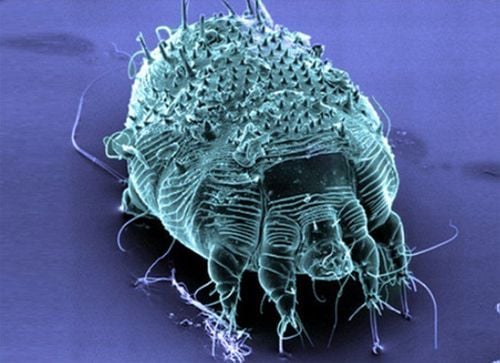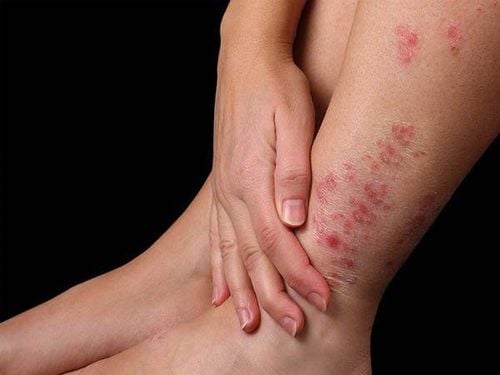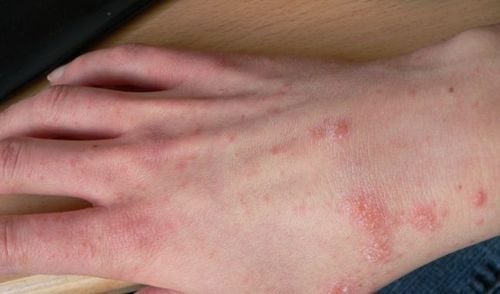This is an automatically translated article.
The article was written by Specialist Doctor I Le Thi Thu Hang - Dermatologist, Department of Medical Examination & Internal Medicine - Vinmec Hai Phong International General Hospital.Scabies is a fairly common dermatological disease in our country. The disease often occurs in densely populated areas, cramped housing, poor sanitation, lack of running water. Although it does not cause serious health consequences, if the early signs of scabies are not recognized and treated in time, the disease can lead to serious complications: infection, eczema, glomerulonephritis. grant.
1. How common is scabies?
Scabies was first identified in the 1600s but was not considered a cause of skin disease until the 1700s. An estimated 300 million people worldwide are infected with scabies.Scabies affects all walks of life, with children and women more susceptible. The disease tends to circulate more in urban areas, especially in densely populated areas, with poor sanitation conditions. The disease is more common in winter than in summer.
The incidence of scabies has increased over the past two decades. In developed countries, scabies is still one of the most common dermatological diseases, greatly affecting quality of life and high treatment costs. The transmission of the parasite is mainly through close contact with the carrier or through objects contaminated with scabies eggs or scabies mites.
2. What causes scabies?
The disease is caused by the parasite scabies (Sarcoptes scabiei hominis). The disease is mainly caused by female scabies, male mites do not cause disease because they die after intercourse.The scabies has four pairs of legs, about 0.3 mm in size, so small that it is difficult to see with the naked eye. They cannot fly or jump, and have a life cycle of about 30 days in and on the epidermis. Female scabies parasites in the stratum corneum of the epidermis, burrows at night, lays eggs during the day, lays 1 - 5 eggs every day, the eggs hatch into larvae after 72 - 96 hours, after 5 - 6 molts (within 5 - 6 molts) 20 - 25 days) becomes an adult scab, then crawls out of the burrow, copulates and continues to dig tunnels, laying new eggs.
Scabies proliferate very quickly, with favorable conditions: 1 female scabies after 3 months can have a family of 150 million children. At night, female scabies crawls out of the burrow to look for male scabies, this is the most itchy time (signs of itching at night), the most contagious, because scratching causes scabies to scatter on clothes, bedding...

3. How is scabies transmitted?
Scabies is spread by sharing beds, sharing clothes, and through skin-to-skin contact during sex, so it can be classified as a sexually transmitted disease (STD). The disease may appear as outbreaks in collective units such as kindergartens, the military, densely populated areas, cramped houses, prisons...4. What are the signs of scabies?
Scabies-specific lesions are scabs and blisters (also called pustules and tunnels).The tunnel is dug by the scab in the stratum corneum, this is a zigzag curve, 2-3 cm long, the edge is higher than the surface of the skin, opaque white or grayish white, does not match the skin. At the top of the tunnel there are vesicles 1 - 2 mm in diameter, which is the residence of the scabies. Tunnels are commonly found between the fingers, palmar lines, wrist creases, and glans. In small blisters, remove the needle to reveal the gray or black color, use a needle to catch the scabies attached to the tip of the needle.
Blisters arranged scatteredly and separately in thin skin such as between fingers, palm lines, front of wrists, forearms, breast folds, around the waist, navel, between buttocks, inner thighs and thighs genitals. In infants, blisters may appear on the soles of the feet. On the glans, scabies can cause a sore called a scab, easily confused with a syphilis chancre.
Signs of itching a lot at night because when going to sleep, the mites move causing irritation to the sensory nerve endings in the skin and partly due to the toxin secreted by the female scabies when burrowing.
Itchy scratching causes infection. Scratches, abrasions, papules, scabs, blisters, pustules, impetigo, dark scars, discolouration... create an image that is likened to a picture of "mother of pearl" or "brocade flower" painting. ". Secondary lesions and complications of infection, dermatitis, eczema often mask, obscure specific lesions and make diagnosis difficult.

5. Scabies is divided into many different diseases
Simple scabies: Only tunnels and vesicles, few secondary lesions. Scabies infection: There are lesions of scabies and pustules, due to superinfection of streptococci, staphylococci, complications of acute glomerulonephritis may occur. Scabies skin inflammation, eczema: Due to long-term rubbing and scratching, in addition to scabies lesions, there are also inflammatory skin patches that are red patches of skin with blisters, long-term itching will become eczema. Infected scabies with complications of acute glomerulonephritis. The best prevention of scabies is to avoid contact with the source of the disease, sick children, not sleeping together, not sharing pants, clothes, blankets. Daily personal hygiene for children with soap, especially in folds such as: Between fingers, groin, navel...Doctor Thu Hang has over 10 years of experience in the field of dermatology. Especially experienced in the treatment of adult and pediatric skin diseases, sexually transmitted diseases, autoimmune and rare skin diseases. The doctor has obtained certificates and university degrees at home and abroad such as: Degree I - Dermatology, Hanoi Medical University, DFMS Degree - Dermatology, University of Paris XIII, France before becoming a doctor. dermatology at the Department of Internal Medicine, Vinmec Hai Phong Hospital today.
Please dial HOTLINE for more information or register for an appointment HERE. Download MyVinmec app to make appointments faster and to manage your bookings easily.














